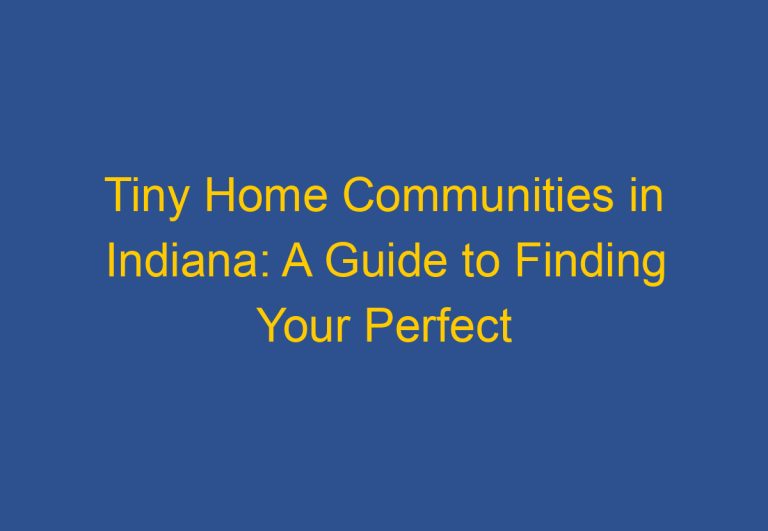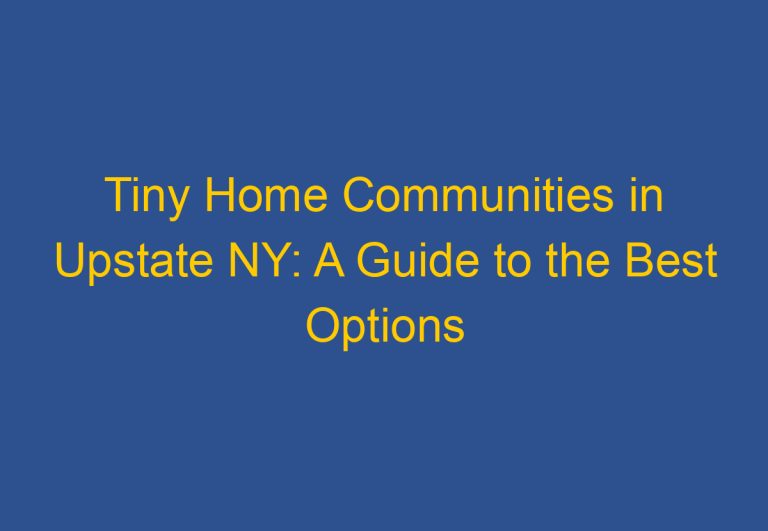Tiny Home Communities in New England: A Guide to Finding Your Perfect Community
Tiny home communities have been steadily gaining popularity as an alternative to traditional housing options in New England. These intentional neighborhoods consist of small, eco-friendly homes, emphasizing a minimalist lifestyle, sustainability, and a strong sense of community. Many people are drawn to the idea of living in a tiny home community due to the lower cost of living, reduced environmental impact, and the opportunity to build meaningful connections with like-minded individuals.

One of the most popular states for tiny home communities in New England is New Hampshire. The state boasts a range of tiny home communities, each with its own unique features and amenities. For example, the Wildflower Tiny Home Community in Laconia is a residential community of 140 tiny homes nestled in the scenic White Mountains of New Hampshire. It is just minutes away from Lake Winnipesaukee, offering easy access to outdoor activities like fishing, boating, and hiking. Another popular option is the Tuxbury Pond RV Resort, which offers tiny homes on wheels within 30 minutes of the Salisbury-Hampton beaches, museums, and outlet malls.
Overall, tiny home communities in New England offer a unique and sustainable way of living that is becoming increasingly popular. With a range of options available in New Hampshire and other states in the region, anyone interested in this lifestyle can find a community that suits their needs and preferences.
Exploring Tiny Home Communities in New England

Tiny Living Philosophy
The tiny house movement is all about embracing a minimalist lifestyle and sustainable living. It is a philosophy that encourages people to live with less and reduce their carbon footprint. Tiny homes are eco-friendly and require fewer resources to build and maintain, making them a popular choice for those who want to reduce their environmental impact.
New England’s Embrace of Tiny Homes
New England has been at the forefront of the tiny house movement, with many communities embracing the concept of tiny living. These intentional neighborhoods consist of small, eco-friendly homes, emphasizing a minimalist lifestyle, sustainability, and a strong sense of community. Tiny homes are an affordable housing option that provides residents with the opportunity to live a simpler life and reduce their impact on the environment.
Legal Landscape and Zoning Regulations
While the tiny house movement is gaining popularity, there are still many challenges to overcome, especially when it comes to zoning regulations and building codes. Each state has its own set of regulations, and it can be difficult to navigate the legal landscape. In New England, zoning regulations vary from state to state and can be complex, making it difficult for tiny home communities to get off the ground.
However, many tiny home communities have found ways to comply with zoning regulations and building codes, making it possible for residents to live in these communities legally. It is important to do thorough research and seek legal advice before building or living in a tiny home community to ensure compliance with all regulations.
In conclusion, New England has been a leader in the tiny house movement, with many communities embracing the concept of tiny living. While there are still many challenges to overcome, including zoning regulations and building codes, many tiny home communities have found ways to comply with these regulations, making it possible for residents to live in these communities legally.
Design, Construction, and Amenities

Customization and Design Innovations
One of the most appealing aspects of tiny homes is the potential for customization and design innovations. In New England, there are many tiny home builders who offer a range of design options and customization features. Backcountry Tiny Homes, an entirely female-owned tiny house manufacturer in Hampstead, New Hampshire, offers design and construction services that cater to the unique needs and preferences of their clients. They specialize in the design and construction of tiny homes that are energy efficient, eco-friendly, and built to last.
Construction Materials and Techniques
Tiny homes are typically constructed using a variety of materials and techniques that are chosen for their durability, energy efficiency, and cost-effectiveness. Many tiny home builders in New England use locally sourced materials, including repurposed and recycled materials, to reduce their carbon footprint and support sustainable practices. Wind River Tiny Homes, a tiny home builder based in Chattanooga, Tennessee, constructs their homes using 2×4 framing and closed cell spray foam insulation. This technique ensures maximum energy efficiency and helps to maintain a comfortable temperature year-round.
Community Features and Amenities
Tiny home communities in New England offer a range of features and amenities that foster a sense of community and support sustainable living. Notable tiny home communities in New England include Community A, located in the picturesque countryside of Vermont, which offers communal gardens, a shared workshop space, and regular community events. Tiny Towne in Rochester, New Hampshire, is another tiny home community that offers a variety of home sizes, ranging from 250 to 600 square feet. The community is located in a rural setting and offers easy access to outdoor activities like fishing, boating, and hiking.
In terms of energy efficiency, many tiny home communities in New England are equipped with solar power systems that help to reduce energy costs and support sustainable living. New Hampshire Tiny House Company LLC, a sustainability-focused company based in New Hampshire, provides affordable and sustainable housing to the local community and residents of New England. They offer a range of services, including the construction of detached accessory dwelling units (ADUs) that are designed to be energy efficient and eco-friendly.
Frequently Asked Questions

What are the top-rated tiny home communities in New England?
New England has several highly-rated tiny home communities. Some of the most popular ones include Nantucket Island Resorts in Massachusetts, Lake Shore Village Resort in New Hampshire, and Tuxbury Pond RV Resort in Massachusetts.
How can I find tiny homes for sale within New England communities?
There are several ways to find tiny homes for sale in New England communities. One way is to check real estate listings in the area. Another way is to search for tiny home builders in the region who specialize in building homes for tiny home communities.
Are there any tiny home communities in New England that offer rental options?
Yes, there are several tiny home communities in New England that offer rental options. Some of these communities include Tuxbury Pond RV Resort in Massachusetts, Lake Shore Village Resort in New Hampshire, and Tiny House Village at Mt. Hood in Maine.
Which New England states have established tiny home communities?
Several New England states have established tiny home communities, including Massachusetts, New Hampshire, Maine, and Vermont. Each state has its own unique set of regulations and requirements for tiny homes, so it’s important to do your research before choosing a community.
Can you find luxury tiny home communities in the New England region?
Yes, there are luxury tiny home communities in the New England region. These communities offer high-end amenities and features, such as gourmet kitchens, spa-like bathrooms, and high-end finishes. Some examples of luxury tiny home communities in New England include Nantucket Island Resorts in Massachusetts and Lake Shore Village Resort in New Hampshire.
What amenities are typically available in New England tiny home communities?
New England tiny home communities typically offer a range of amenities, including community gardens, outdoor recreation areas, and communal gathering spaces. Some communities also offer on-site laundry facilities, fitness centers, and swimming pools. The amenities available will vary depending on the community, so it’s important to research each community before choosing one.






